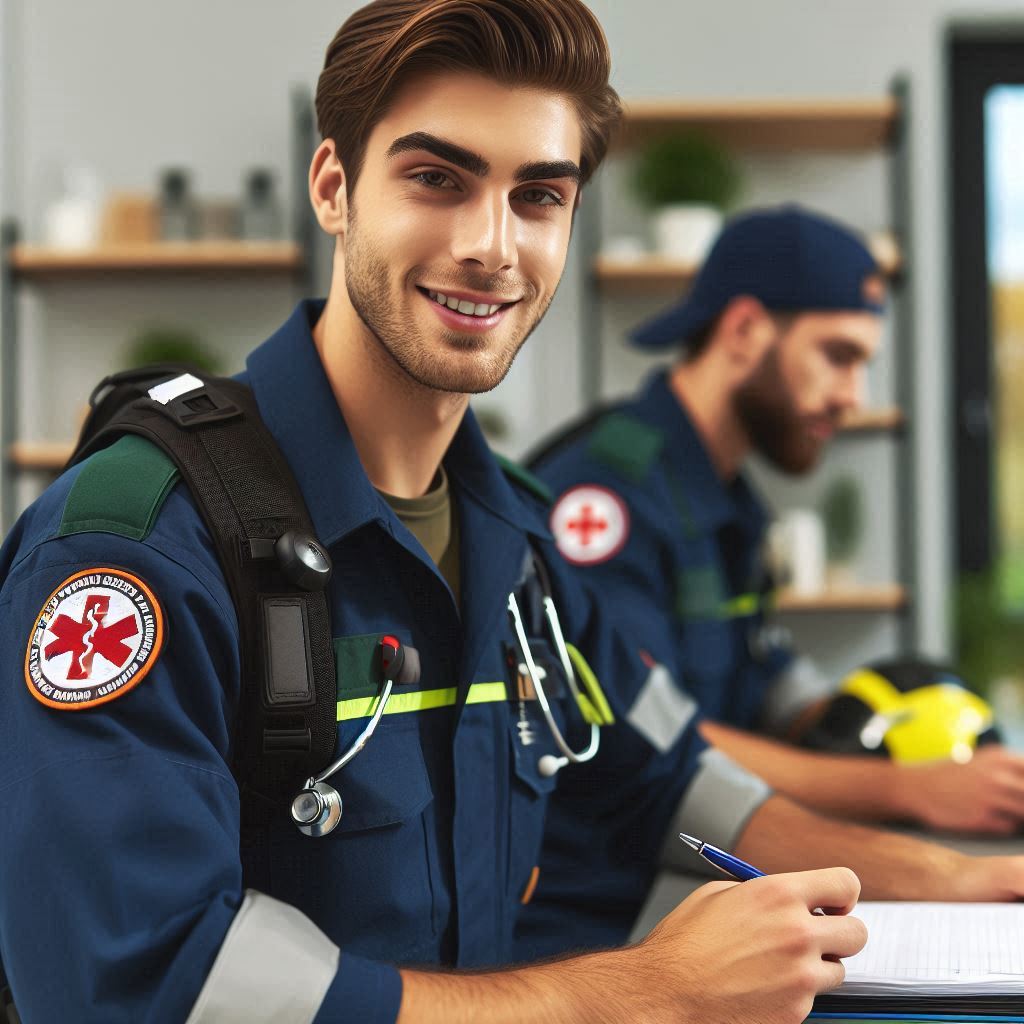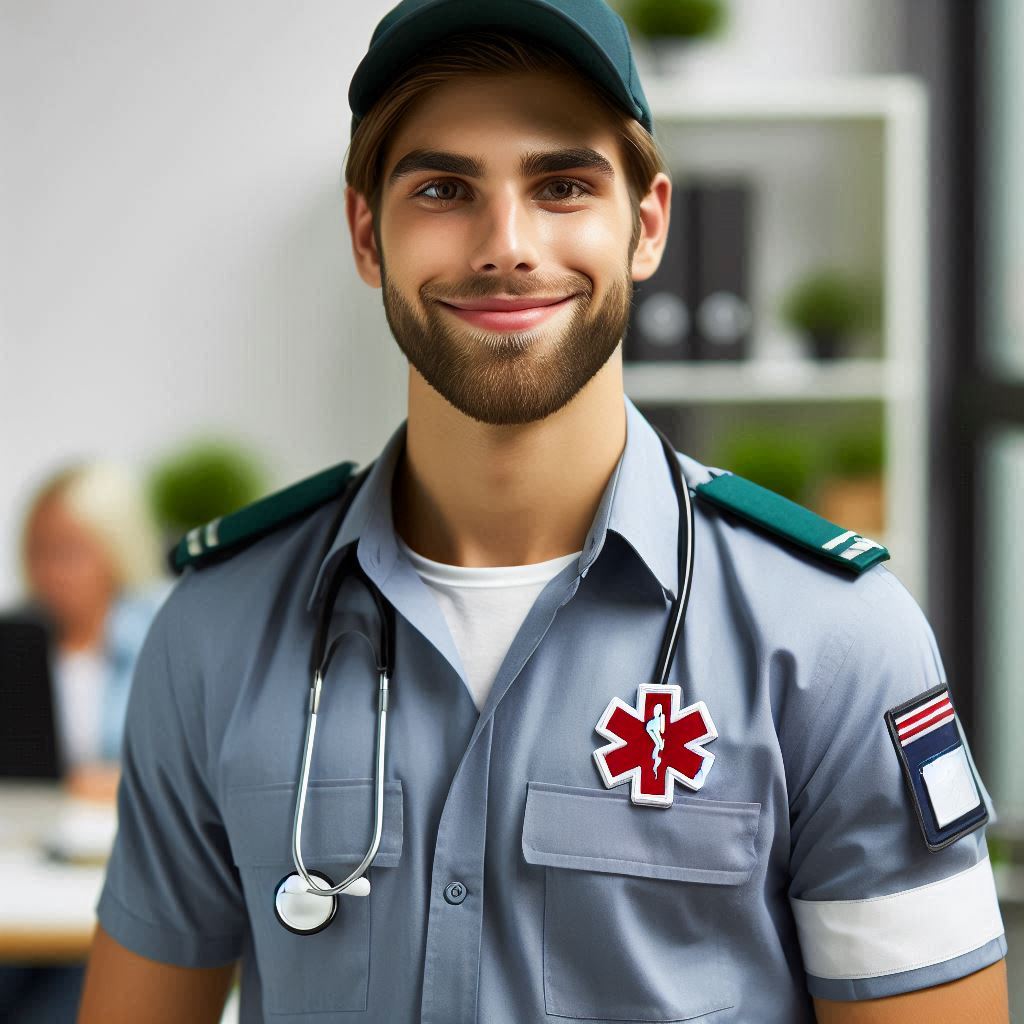Introduction
Paramedic uniforms and gear are vital components in the realm of emergency medical services.
They not only signify professionalism but also enhance the efficiency of paramedics in critical situations.
Proper attire and gear ensure that paramedics are readily identifiable and equipped to handle medical emergencies with precision and speed.
The uniform typically includes durable pants and shirts in distinctive colors, often with reflective elements for visibility.
These uniforms are designed to withstand the rigors of the job, providing comfort and mobility essential for swift responses.
Additionally, specialized gear such as gloves, boots, and helmets protect paramedics from hazards while maintaining hygienic standards.
In the field, paramedics rely on their gear to carry essential medical equipment like stethoscopes, bandages, and defibrillators.
Each piece serves a crucial function in delivering timely and effective care to patients in need.
The strategic placement of tools ensures quick access during emergencies, optimizing response times and patient outcomes.
By adhering to uniform and gear protocols, paramedics uphold a professional image and inspire confidence in their abilities.
This standardized approach not only enhances safety but also fosters trust within the communities they serve.
Ultimately, paramedic uniforms and gear are more than just attire; they are essential tools that embody preparedness, professionalism, and dedication in emergency medical services.
Importance of Proper Uniform
Significance of a proper uniform in identifying paramedics during emergencies
A paramedic’s uniform is more than just attire‘it’s a critical identifier during emergencies.
In chaotic situations, clear identification helps patients and bystanders easily recognize who to approach for help.
This identification not only reassures but also instills trust and confidence, crucial for calming those in distress.
How uniforms can impact the confidence and trust of patients and bystanders
Wearing the right uniform isn’t just about appearance; it’s about safety.
Paramedics operate in hazardous environments where protective gear is essential.
Proper uniforms include reflective materials for visibility in low-light conditions and sturdy fabrics to protect against physical hazards.
Safety aspects of wearing the right uniform in hazardous situations
Reflective strips and bright colors enhance visibility, ensuring paramedics are easily seen during night operations or in dense urban settings.
This visibility is not only for the paramedics’ safety but also for the safety of others, preventing accidents in busy emergency scenes.
Transform Your Career Today
Unlock a personalized career strategy that drives real results. Get tailored advice and a roadmap designed just for you.
Start NowMoreover, the uniform signifies professionalism and dedication to the job, reinforcing public trust in the paramedic’s abilities.
Patients and bystanders rely on these visual cues to gauge the competency and preparedness of the emergency medical team.
In summary, a paramedic’s uniform is a cornerstone of their role in emergency medical services.
It serves as a beacon of hope and assistance in crisis situations, guiding those in need towards the help they require.
Therefore, ensuring paramedics are properly attired isn’t just about protocol; it’s about enhancing safety, building trust, and delivering effective emergency care.
Read: Why Home Health Aides Are Crucial in Healthcare
Essential Gear for Paramedics
Necessary gears
Stethoscope
A stethoscope is a must-have tool for paramedics to listen to heart, lung, and abdominal sounds.
It helps paramedics assess a patient’s condition quickly and accurately, enabling prompt treatment.
Having a high-quality stethoscope is essential for detecting subtle changes in the patient’s condition.
Trauma Shears
Trauma shears are essential for cutting through clothing and seat belts during emergency situations.
They enable paramedics to access and treat injuries quickly, potentially saving precious time in critical cases.
Investing in durable trauma shears ensures they can withstand demanding situations when every second counts.
Gloves
Paramedics must always have a supply of high-quality gloves to protect themselves and patients from contamination.
Gloves are crucial in preventing the spread of infections and maintaining a sterile environment during medical procedures.
Using disposable gloves is essential for reducing the risk of cross-contamination and ensuring safe patient care.
Medical Kits
Paramedics rely on well-stocked medical kits to provide immediate care and stabilize patients in emergency situations.
These kits contain essential supplies such as bandages, gauze, medications, and airway management devices.
Having a comprehensive and organized medical kit is vital for addressing a wide range of medical emergencies effectively.
Importance of Functional and High-Quality Gear
Patient Care
Functional and high-quality gear is essential for delivering efficient and effective patient care.
Well-maintained gear enables paramedics to perform their duties with precision and confidence, ensuring optimal outcomes for patients.
Transform Your Career Today
Unlock a personalized career strategy that drives real results. Get tailored advice and a roadmap designed just for you.
Start NowInvesting in top-notch gear reflects a commitment to quality care and enhances the overall patient experience.
Reliability
Having functional gear that performs reliably under pressure is crucial in emergency medical situations.
Paramedics rely on their gear to function seamlessly in high-stress environments, where every second counts.
Quality gear instills confidence in paramedics and enhances their ability to respond swiftly and effectively to patient needs.
Safety
High-quality gear not only enhances patient care but also prioritizes the safety of paramedics.
Durable gear withstands rigorous use, reducing the risk of malfunctions and ensuring paramedics can perform their duties without hindrance.
Investing in reliable gear demonstrates a commitment to safety and minimizes potential hazards in the field.
In fact, paramedics depend on essential gear such as stethoscopes, trauma shears, gloves, and medical kits to provide critical care to patients.
Each gear item plays a vital role in ensuring prompt assessment, treatment, and stabilization of patients in emergency situations.
By emphasizing the importance of functional and high-quality gear, paramedics can enhance the quality of care they deliver and prioritize the safety and well-being of both patients and themselves.
Read: Safety Tips for Paramedics on the Job
Uniform Requirements and Guidelines
Paramedics are required to adhere to specific uniform standards as outlined by regulatory bodies and EMS agencies.
These standards ensure consistency and professionalism across emergency medical services.
Typically, uniforms consist of durable fabrics designed to withstand the demands of their work environments.
Standard uniform requirements for paramedics set by regulatory bodies or EMS agencies
Regulatory bodies dictate that paramedics wear uniforms that are easily identifiable, often featuring distinct colors and logos.
These visual cues help the public recognize emergency responders quickly in critical situations.
Uniforms may include pants, shirts, and jackets, all designed with functionality and comfort in mind.
Specific guidelines for uniform colors, logos, and personal protective equipment
Uniform guidelines often specify colors that distinguish paramedics from other emergency personnel.
Logos, such as EMS agency emblems, are prominently displayed to signify official status.
Personal protective equipment (PPE) is also a crucial component, including gloves, eye protection, and masks, essential for infection control and personal safety.
Transform Your Career Today
Unlock a personalized career strategy that drives real results. Get tailored advice and a roadmap designed just for you.
Start NowImportance of adhering to uniform policies for professionalism and safety
Adherence to uniform policies is vital for both professionalism and safety.
A consistent appearance instills confidence in patients and the public during emergencies.
Moreover, proper PPE usage underlines a commitment to infection control protocols, safeguarding both paramedics and patients from potential health risks.
In general, paramedic uniforms and gear are meticulously designed to meet stringent standards for functionality, visibility, and safety.
By adhering to these guidelines, paramedics ensure they are prepared to respond effectively in any emergency, maintaining professionalism while prioritizing patient care and safety.
Read: Preparing Patients for Blood Draws: A Phlebotomist‘s Guide

Personalization and Comfort
Personalization with Name Tags or Badges
One way paramedics can personalize their uniforms is by adding name tags or badges.
This not only helps in identification but also adds a personal touch to their attire.
When dealing with high-stress situations, knowing each other’s names can build camaraderie and trust among team members.
Importance of Comfort in Uniforms
Comfort is key when choosing uniform materials and sizes, especially for paramedics who have to work long shifts.
Uniforms that are too tight or uncomfortable can impede movement and cause unnecessary distractions during emergency situations.
It is crucial to select breathable fabrics that allow for flexibility and comfort throughout the day.
Tips for Maintaining and Cleaning Uniforms
- Regularly wash uniforms and gear according to manufacturer guidelines to ensure longevity.
- Check for any wear and tear and repair or replace as needed to maintain professional appearance.
- Avoid using harsh chemicals or bleach when cleaning as it can damage the fabric.
- Store uniforms in a clean and dry place to prevent mold or mildew from forming.
- Consider investing in multiple sets of uniforms to rotate and reduce wear on individual pieces.
Overall, personalizing uniforms with name tags or badges, prioritizing comfort in material choices, and maintaining clean and well-maintained gear are essential for paramedics to perform their duties effectively and professionally.
Read: The Role of Technology in Modern Paramedic Work
Find Out More: Continuing Education for Home Health Aides
Discover More: Importance of Cultural Competence in Health Education
Upgrades and Innovations in Uniforms
Recent advancements in paramedic uniforms and gear technology
Recent advancements in paramedic uniforms and gear technology have revolutionized the field.
These innovations focus on enhancing the efficiency and comfort of paramedics.
Cutting-edge fabrics, such as moisture-wicking materials, keep paramedics dry during long, strenuous shifts.
Integrated communication devices within the uniforms have also become more prevalent, enabling seamless, hands-free communication in high-stress situations.
Transform Your Career Today
Unlock a personalized career strategy that drives real results. Get tailored advice and a roadmap designed just for you.
Start NowAdditionally, lightweight, breathable fabrics help reduce fatigue, allowing paramedics to perform their duties more effectively.
How new materials or designs can improve comfort, durability, and functionality
New materials and designs significantly improve the comfort, durability, and functionality of paramedic uniforms.
Ergonomically designed uniforms ensure better fit and ease of movement, essential for performing critical tasks swiftly.
High-durability fabrics withstand the rigors of the job, from physical abrasion to exposure to hazardous substances.
Improved ventilation and moisture management systems keep paramedics cool and dry, enhancing their comfort during prolonged periods of activity.
These materials also offer greater resistance to wear and tear, extending the life of the uniforms and ensuring they remain reliable even in the most demanding conditions.
Innovative features like moisture-wicking fabric or integrated communication devices
Innovative features like moisture-wicking fabric and integrated communication devices have become essential in modern paramedic uniforms.
Moisture-wicking fabrics draw sweat away from the skin, maintaining dryness and comfort, which is crucial during intense, high-pressure situations.
Integrated communication devices, such as microphones and earpieces, facilitate continuous and clear communication between team members and dispatch centers.
This technology allows paramedics to receive real-time updates and coordinate effectively, enhancing their response efficiency.
Additionally, uniforms now incorporate reflective materials for improved visibility in low-light conditions, increasing safety during nighttime operations.
Advancements in paramedic uniforms and gear technology are transforming the field, focusing on enhancing comfort, durability, and functionality.
With innovations like moisture-wicking fabrics and integrated communication devices, paramedics can perform their duties more effectively and safely.
These upgrades reflect ongoing efforts to support paramedics with state-of-the-art tools that not only meet but exceed the demands of their challenging profession.
As technology continues to evolve, paramedic uniforms and gear will likely continue to advance, ensuring that emergency medical responders are equipped with the best possible resources to save lives and deliver exemplary care.
Training and Education on Uniform and Gear Use
Importance of proper training for paramedics on how to use and maintain their uniforms and gear
Proper training for paramedics is essential to ensure they know how to use and maintain their uniforms and gear effectively.
This training should cover topics such as the proper way to put on and take off protective gear, how to clean and sanitize uniforms, and how to inspect equipment for any damage or wear.
Regular equipment checks are crucial for paramedics to be prepared for emergencies.
Paramedics should routinely inspect their gear to ensure it is in good working condition.
This includes checking for any tears or signs of wear on uniforms, ensuring medical equipment is up to date and functioning correctly, and stocking necessary supplies.
Transform Your Career Today
Unlock a personalized career strategy that drives real results. Get tailored advice and a roadmap designed just for you.
Start NowSignificance of Regular Equipment Checks
- Ensures gear is in good working condition.
- Reduces the risk of malfunctions during emergencies.
- Increases efficiency in responding to calls.
- Enhances overall safety for both paramedics and patients.
Paramedics can benefit from additional education or courses on uniform and gear essentials to further enhance their knowledge and skills.
There are various resources available, such as online training modules, workshops, and certification programs specifically focused on paramedic uniforms and gear.
These resources can provide paramedics with more in-depth information on the latest technologies and best practices in maintaining their gear.
Resources and Recommendations for Additional Education
- Consider attending workshops and seminars on uniform maintenance.
- Look for online courses that focus on gear essentials for paramedics.
- Seek certification programs in emergency medical services.
- Join professional organizations for paramedics to stay updated on industry standards.
In a nutshell, proper training, regular equipment checks, and additional education are vital for paramedics to effectively use and maintain their uniforms and gear.
By investing in their knowledge and skills, paramedics can ensure they are always prepared to respond to emergencies with confidence and efficiency.
Conclusion
Summarizing the key points about paramedic uniforms and gear essentials, it is crucial to emphasize the importance of proper attire and equipment for paramedics.
These professionals rely on their uniforms and gear to execute their duties effectively and maintain a high level of professionalism.
Investing in quality uniforms and gear directly impacts patient care outcomes, as well as the overall performance of paramedics in the field.
The right tools enable paramedics to respond to emergencies efficiently and provide the necessary medical assistance to those in need.
Therefore, it is essential for readers to prioritize acquiring the appropriate uniforms and gear to ensure that paramedics can perform their roles effectively and efficiently.
By choosing the right attire and equipment, paramedics can enhance their capabilities and deliver top-notch care to patients in various situations.
[E-Books for Sale]
The Big Book of 500 High-Paying Jobs in America: Unlock Your Earning Potential
$19.99 • 500 High-Paying Jobs • 330 pages
Explore 500 high-paying jobs in America and learn how to boost your career, earn more, and achieve success!
See All 500 High-Paying Jobs of this E-Book
1001 Professions Without a Degree: High-Paying American Jobs You Can Start Now
$19.99 • 1001 Professions Without a Degree • 174 pages
Discover 1001 high-paying jobs without a degree! Unlock career tips, skills, and success strategies for just $19.99!




